| Free and easy with a couple of small bottles. |
| Nice breathable gel-sized pocket on one side. |
| Smaller, key/salt-tab sized pocket on the other |
Written by Andrew Burton - http://www.mountain-lite.co.uk
Written by Kurt Dusterhoff - http://cotswoldrunning.blogspot.co.uk
| Free and easy with a couple of small bottles. |
| Nice breathable gel-sized pocket on one side. |
| Smaller, key/salt-tab sized pocket on the other |
Written by Paul Ali - http://ultraavon.com
I had the opportunity to trial the new Inov-8 Race Vest 10 and my first impressions are detailed below.
Inov8 released the Race Ultra vest about a year ago and it has become a fairly popular choice judging by the number of times I have seen it at races and I also purchased one myself which is probably me go to pack for races where kit requirements are not too extensive. However, the major limitation was the lack of capacity for longer races where there were more onerous mandatory kit requirements. Therefore, the new Inov8 Race Ultra pack race pack has been designed to address this need for more capacity and comes in 5L and 10L versions. I had the opportunity to test the 10L version.
Front view
Close up view of the side pockets
The pack is similar in design to the previous Race Ultra vest. Thankfully, they have changed the fiddly pin clip of the previous version to a more traditional slide-in clip. The front boasts 8 pockets, with 2 each side of the chest and the bottle pouch on the previous version has been replaced with a smaller zipped pocket which houses the soft flask and is surrounded by a small “dump” pocket. There is also a small whistle on the front but it is not very loud and its debatable whether this would pass kit check for some mountain races.
Rear view
Inside of the pack is a pocket which can be used to store items you would like to get to easily. There is a rear bungee compression cord on the back for tightening the pack or perhaps carrying something outside the pack.
Peek inside the rear compartment
The back of the pack boasts a zipped compartment which holds up to 10L of kit and there is an extra zip which allows access to a separate reservoir compartment. The pack comes with 2 x 500ml soft flasks attached to “straw”tubes.
Soft flask and tube
Please note that the water bottles from the previous Inov8 Race Ultra vest (which I own) are not compatible with this pack. You ‘could’ just about squeeze with flat design water bottles into the zipped pocket but it wouldn’t slip in and out easily and isn’t designed for this pack.
Testing
Testing the pack
I trialled the pack on a few short runs but the main test was over a weekends hiking and running along the South West Coast Path. I was visiting this area as part of a recce for a future race and had elected to bring all the mandatory kit to test the packs suitability.
I spent two full days using the pack and was pleased to say it got a good workout. In particular the changeable weather conditions on the second day (i.e. wind and heavy rain) meant that in addition to trialling the comfort and design of the pack, I was also testing its ease of use by accessing the pack on a number of occasions to access my waterproofs, hats or other food/equipments and its weather resistance!
What I liked
I liked the style and design of the Inov 8 Race vest partly as an owner of last years version. The front pockets are slim, accessible and the right size for small items such as your phone and i-Pod or snack. The pack is also very lightweight (about 260g for the S/M 10L version and 265g for the M/L 10L version) and felt comfortable to use (see my note on sizing below though).
I also thought the dump pockets and the side were particularly useful for litter or small items aswell such as a snack but items are not secure in this pocket if you remove the pack.
View of the straw tubes on the front
The rear compartment offers plenty of space and the contents are easily accessible via a zip across the top. I don’t know why other race vests don’t have a zip across the rear compartment (i.e. previous Inov8 Race vest and Salomon S-lab) as it gives you greater security that something won’t fall out and can protect it from the elements more. I’m not a fan of these fold over style clips to be honest.
The zip is quite wide giving you easy access to kit in the rear compartment. I could carry all of my required mandatory kit for the race (including maps, waterproof map case, extra layer, leggings, food, head-torches, compass, whistle, hat, gloves) and there was room to spare. This area of the pack had more of a pronounced bulge on the back as it sits higher up on your back but it didn’t feel uncomfortable.
Pack loaded with a typical coastal/mountain race list of mandatory kit
The newer design with more space on the back means the pack can be used across a variety of events from a short ultra to one where there are mandatory kit requirements. I can usually fit most of the kit in the Inov8 race vest even up to say a typical Centurion 100 mile event but this would probably not be possible for a coastal or mountain type ultra runs where there are additional requirements such as full body covering or full waterproofs and extra layers for example.
What I didn’t like
After trying out the hydration system, I can’t say I was comfortable with the design. The two hydration straws seemed to flap about in front of me whilst running and started to become a minor annoyance. You could cut the tubes slightly to make these lower and less likely to swing in your face but I elected to replace the hydration tubes with screw on tops to the soft flasks to avoid this concern (my screw on tops from the Salamon soft flasks fitted).
Straw tubes
I generally use a pack with soft flasks or bottles (Inov8 Race Ultra Vest – original or a Salomon Slab 12) and like the freedom to slip them out of a pack, drink away and refill them quite quickly. The soft flask pockets sat up to the side of my rib-cage area and I didn’t find it easy to slip the soft flasks in or out when trying to drink from them or re-fill them to be honest.
The pack was comfortable and fitted tightly around your body. However, I felt these packs came up a little small. As a 36” chest I tend to use the Small/Medium size as opposed to the Medium/Large. If you are considering buying this pack and are on the border between the S/M or M/L then I would suggest you go for the larger size. I’m not sure if the race vest was intended to be used without the straws or not and the sizing concern may have been a factor in my views of the lack of ease of use of the soft flask holders so something to consider.
In fact it was a little easier to access the soft flasks by putting these into the dump pockets which were positioned on the side under the armpit.
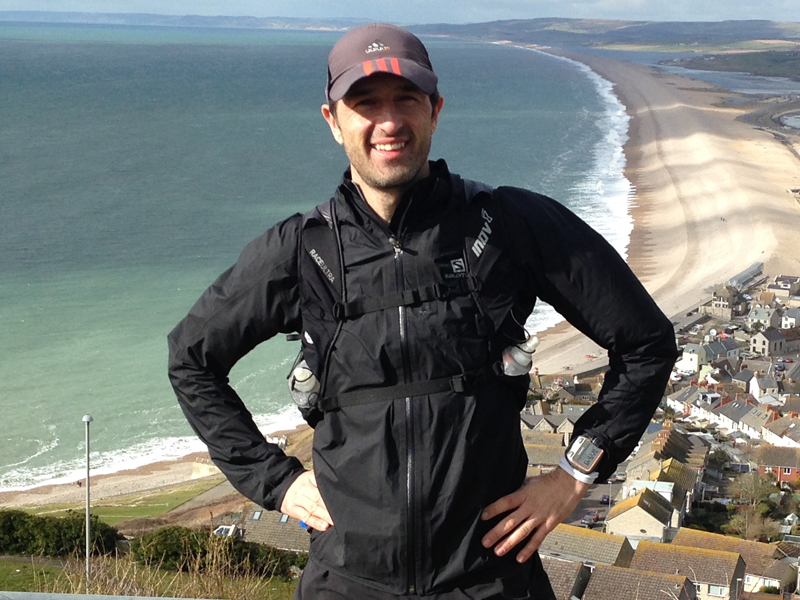
Pictured with straws replaced with Salamon soft flask tops
Summary
If you don’t own a race vest (such as the S-Lab Advanced Skin Race Vests) then this is a viable alternative if you are happy with this particular hydration system on the pack (i.e. soft flasks and the straws). Unfortunately, the hydration system didn’t suit me personally and this was the only real negative area and I guess it’s a matter of personal preference.
The pack is comfortable, very light weight, offers plenty of space in the rear compartment which is easily accessible but would suggest you size “up” if you are a borderline Medium size.
If you asked me what would it take to turn this into the ‘perfect’ pack for me, then I would change the hydration system to the front mounted bottles, and perhaps add zips to the smaller pockets on the front and make sure I was happy with the sizing but that would be about it.
If you are considering this and are not sure between the 5L or 10L version then I would go with the larger version which has a minimal weight difference but gives you more capacity and both vests sits tightly around the body,
The pack is available to purchase in 5L and 10L sizes from the ULTRAmarathonRunningStore at the link here (10L) or here (5L) who kindly supplied the pack for trial and review.
Written by Neil Bryant for the URC

Vest with 10 litre pocket clipped in place on the rear
As mentioned previously in other reviews, I have been a Salomon vest user, and have been happy enough to not be concerned with looking elsewhere. I recently reviewed the Montane Gecko vest and was really happy with it, which made me want to try some other non-Salomon vests. The inov-8 range of vests looked really well thought out, but the Race Ultra Pro 2 in 1 in particular stood out as something really adaptable and innovative. Fortunately for me, inov-8 offered one for me to review.
What I like about this vest in particular, is the fact it seems to be the vest with it all. It can be a stripped down to a small race vest, or it can have the 10 litre pocket clipped to the rear section to make the volume larger and so better suited for days where you need to carry more. This is a great idea, and if it works well, will be a great way of having one vest for all occasions.
Secondly, there are the bottles and the way they can be reconfigured to whatever you prefer. There are ‘traditional’ bottle pockets fairly high up on the front, which I prefer, probably as I am so used to my Salomon. But, in case you prefer a straw on your bottle then there are also pockets below the 'traditional’ ones to place the bottles with the straws easily fitted, leaving the ends rights next to your mouth making sure you don’t forget to drink. The vest is sold with these two flasks (produced by Hydrapak) with the straws which you can just remove if you want. Unusually, you also get a HydrapakSpeedcup which is a brilliant piece of kit that folds up into nothing and is often obligatory kit in many races these days.

Here it is set up with the straws on the flasks, stowed in the lower pockets.
On top of these features, there are a wide variety of seemingly well thought out, useful pockets, pole carriers (which enable front or rear stowage!). A weather/sweat proof pocket on the back and quite a few of the pockets being zipped which is nice for all those valuable items we carry these days.
So, on paper, and indeed, when I had one in my hands, it felt like a great piece of kit with huge potential. But would this carry through, once I’d used it a few times?
I first carried it on a 2hr run. Around 1000 metres up and then back down, which would certainly give me a good chance to see how well it fares with being shaken around lots. A vest is of no use to me if it rubs, so this is a test that any vest I use needs to pass. On the first run, it was great. It hugged me firmly at all times, even on the steep and technical terrain I was hurtling (Think Kamikaze, not Kilian!) down. I am not the smoothest of descenders, so vests are well tested! My collar bones, stick out a fair bit, and this is often the point of irritation on me, but there was nothing. The pockets seemed all accessible even with my not very flexible arms. Everything seemed to stay secure too meaning there was no continuous tightening of straps as things shook loose (An issue I had with the Montane Gecko). I was happy! My next big run I had planned was the OCC race (56km), and I felt confident enough to take the inov-8 vest out for its second outing here.
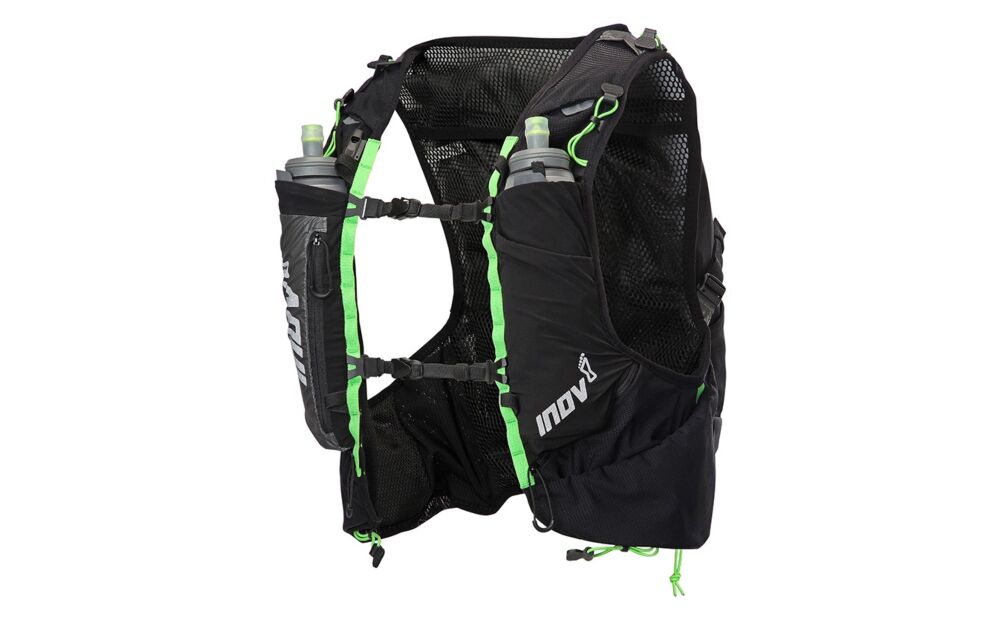
...and here with the flasks, strawless, stowed in the upper pockets
Well, the race really didn’t go too well for me (understatement), but the vest was really impressive. If I had to pick out a negative, it feels petty, but this is the point of a review I guess, when I removed the bottles at checkpoints to refill, on trying to slide them back in, it wasn’t too easy. I think this was due to the larger pockets below putting pressure on it. Other than this, it was superb. Over 9 hours of running / walking and it was as comfortable at the end as on the start line. Often at the end of races, it is a joy to remove my vest, but this time it didn’t cross my mind. A sure sign of comfort!
I have since used it many times, and it has now become my main pack. It also seems relatively durable considering the light weight (255g at stripped weight minus bottles. 345g with extra pocket minus bottles) . I am always happy with gear being a little more durable for a few extra grammes.
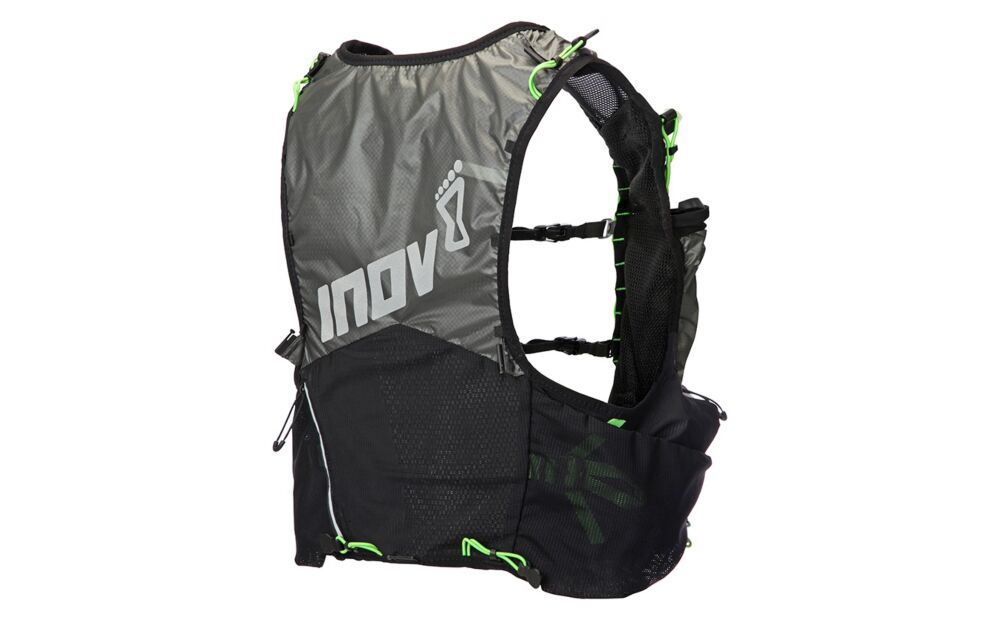
Here in its stripped down (10 litre pocket removed) lightweight mode.
In summary, the inov-8 Race Ultra Pro 2in1 really does deliver. I have really tried to think of anything negative about the vest so this doesn’t turn into a ‘I’d better not say anything bad about this freebie’ sort of review, but other than the bottles not sliding in easily, I really couldn’t think of anything. It only comes in the black and green colours as shown which I guess could be a negative for some. It fits me perfectly, but of course we are all different shapes and sizes, so I assume not everyone will have the same experience as me. Let me know what you thought of it if you have tried one on at some point. I am always interested to hear what the general consensus is.
If you are in the market for a new or indeed, first vest, then I would advise trying on the inov8, and if it fits you as well as me, then I am fairly sure that you will be buying one! Price wise, it sits fairly high, I initially thought, at £150 (on the inov8 site), but when you take into account the fact that you can add the extra volume, and it comes with two flasks with straws and a collapsible cup (which total £54 worth if bought separately!), it is actually well priced.
My Salomon vest may well be gathering dust in the cupboard for a long time now...
For more details, Check it out on the inov-8 site here
To buy the inov-8 Race Pro 2in1 vest and to support the URC, then please use the following link. Thanks
Written by Guy Oliver http://outdoorguyuk.tumblr.com

The core staple of any fastpacking trip is clearly the backpack. Tents, bivouacs, sleeping bags and all the other kit are certainly important, but you’re going to need something to carry them in that doesn’t hinder your movement.
It would be easy to assume that finding a backpack for fastpacking would be a relatively easy affair, due to there being so many running specialist companies out there. Indeed, there are a whole load of companies making running specific packs, however they tend to focus more on either extremely lightweight water and gel carrying backpacks made for supported races, packs for carrying a small amount of kit (5-20 litres) and commuter packs made large enough to carry a small change of clothes. The number of packs in a company’s range large enough to accommodate equipment for multi-day fastpacking trips whilst being functional for a runner significantly decreases. Not to say there aren’t many, but there are much less to choose from and these larger sizes don’t seem to be as frequently stocked in sports/hiking shops in the UK.
With an extremely spartan setup, you may be able to fit your kit into a 20 or 25 litre backpack - this could be achieved with no camping mat and a bivi-bag in good weather, however I believe that 30 litres is the ideal size, at least for the kit that I’m using. Bearing that in mind, I began searching for a new backpack that would not only be big enough for multi-day trips, but also be comfortable and functional for long distance running.
After much research, I kept coming back to the Inov8 Race Pro 30. It’s not the newest backpack in their range, I believe it was launched in 2007 but don’t quote me on that, however it was the exact size that I was looking for. It was a hard decision between their newer Race Elite 24 (litre) backpack, although the extra capacity and ability to use the Inov8 Horizontal Bladder (more on that later) won the decision for me. I still intend to get the Race Elite 24 (pictured Below) however as it wins hands down on weight (291g compared to the Race Pro 30’s 702g) and I’m keen to see the difference.
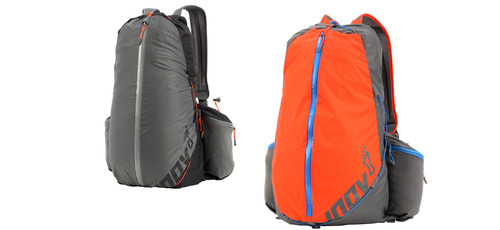
Without nerding out on the tech spec too much, the Race Pro 30 is a 30 litre running backpack with a back length of 50.7cm. It was designed for long distance ultra/adventure running races, mountain marathon and trail runs, and endurance mountain bikers, for which it certainly fits the bill.
The pack features a large central compartment for storage, a weatherproof zipped compartment in the lid, two open stretch mesh outer panels for easy access, a zipped mesh storage lid, and two zippered weatherproof pockets in the waistband large enough to store multiple gels and chews, or mobile phone, keys, compasses or snacks. The pack also has the plastic fasteners allowing the option of utilising the Inov8 attachable mesh pockets, to create additional easy access space at the front of the straps. Below is a description by Inov8 of the 22 litre version to give an idea of where features are located.
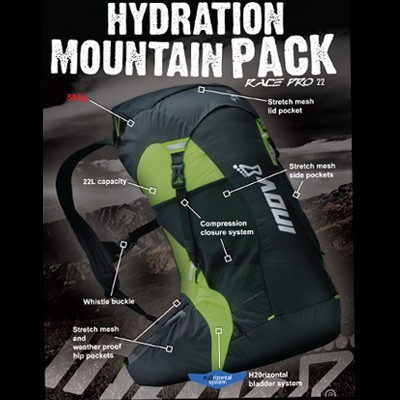
A feature that Inov8 included for the Race Pack Pro 30 is the much applauded horizontal water reservoir. The reservoir sits in a separate section of the backpack that wraps around the lumbar region, offering increased stability and a lower centre of gravity for the pack. The reservoir features multiple compartments to prevent sloshing of the water and because it sits within it’s own separately zipped compartment at the bottom of the bag, is much easier to remove to refill than a vertical bladder that sits within the main compartment.
As the Race Pro 30 is an outdated model, the bladder that it was designed to carry has been discontinued, meaning that the new design bladder can not be refilled as easily without removing it, however it is still possible. I contacted Inov8 who were fast to reply to me with a great critique of the pros and cons of using the new bladder with the backpack. They were honest that it would not fit correctly, however were probably a little too honest, as when I bought mine after their reply, I found it worked considerably better than they had led me to expect.
Below are images of the discontinued blue bladder model, followed by the newer orange/black model. You can see that the blue model allows filling from the top, making for a better fit in the Race Pro series with easier refilling whilst installed, whereas the newer model is filled from the side, allowing it to be hung vertically or horizontally, but at the expense of not fitting as neatly in the older backpacks.
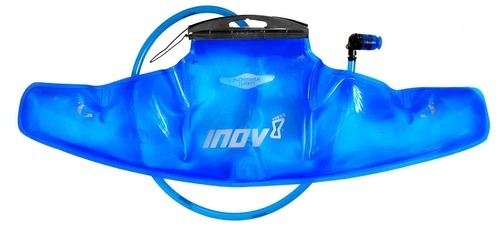
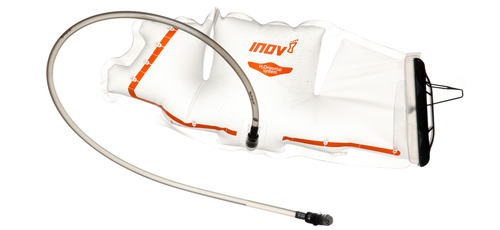
The horizontal bladder is amazing. I’ve used vertical bladders before and usually with a lot of frustration. The bite valves are not comfortable, you have to pull too hard, removing them to refill is awkward and water bottles are just easier. The Inov8 bladder has changed my opinion of this. My only criticism would be that I would like to have an adjustable flow rate - most bladders seem to be a little too hard to draw on and the added effort of trying to suck out an adequate amount of water whilst running can sometimes be enough to make you out of breath. Despite this, it’s still ideal for fastpacking as I rarely drink on the run. It might be a disadvantage for racing, however when fastpacking there are plenty of opportunities to slow down or take breaks to enjoy a view and have a drink. It also only weighs a tiny 130g, whilst feeling extremely robust.
In terms of looking at the Inov8 Race Pro 30 as a fastpacking backpack, I believe it would be quite hard to improve upon it. The stretch mesh pockets are amazing at keeping items of different sizes and shapes steady, the lid strap mechanism compresses the bag perfectly regardless of load size and the waist, chest and shoulder straps work wonders at keeping the bag stable when running. The capacity is fantastic and the price is incredible - I purchased mine for just over £40.
Below is an example of the amount of kit that comfortable fits in the backpack for a fastpacking trip. I usually bring warm clothes for the evenings which aren’t in the picture, but you get the idea.

My only personal criticism of the pack were that despite being quite short and stocky, I had to pull the , shoulder, waist and chest straps almost to their tightest setting. Most runners are much slimmer than I am, so I wonder how they would fare if they wanted a close fit. Separately, the shoulder straps ride close to my neck and tend to rub when I run which can be uncomfortable over long distances, although I alleviate this by wearing a buff around my neck. Inov8 have also managed to drop nearly 60% of the weight and only 6 litres capacity in the new Race Elite 24, although I suspect with a heavier load, the extra padding and robustness of the Race Pro 30 might win out. It’s also possible to remove the pad in the back to drop a little extra weight for less comfort, so there is an option.All in all, a great piece of kit, especially for the price. I’m keen to try out some of the newer Inov8 packs to see how they fare - especially as they’re even more lightweight.
The Inov8 Race Pro 30 gets a big thumbs up from me.
Links to products mentioned in this article -
Inov8 Race Pro 30 - http://www.inov-8.com/New/Global/Product-View-RacePro-30.html?L=27
Inov8 2L H20rizontal Reservoir - http://www.inov-8.com/New/Global/Product-View-Horizontal-Reservoir-SS14.html?L=26
Inov8 Mesh Pocket (not reviewed) - http://www.inov-8.com/New/Global/Product-View-Mesh-Pocket-SS14.html?L=26
Written by Kate Allen

When I entered my first Ultra race I quickly realised the importance of having some sort of pack to carry all the essential items needed to get me through 100kms on the trail. I started window shopping online but found that many packs were large and bulky. My race is a) in the summer and b) should (!) be finished within a day so I would not be needing space for a sleeping bag, thermals and gas stove. Thankfully, Accelerate then announced they would be taking pre-orders for the Inov8 Ultra Race Vest and after reading up about it, decided it looked just the ticket for me. I bought it, then waited impatiently for it to arrive in the UK.
I was besides myself with excitement when I finally opened the Accelerate package and was not disappointed with first impressions. The vest looks small but it came with a 2 litre bladder, hose, two 500ml bottles and a removable whistle. I had already read other reviews that complimented the vest on its fit and adaptability to all forms through the clever design; what I was most concerned about was its ability to carry everything I needed despite its lightweight construction.
Firstly, the new fasteners gave me pause for thought and I quickly checked there were no instructions with the vest. After several blonde moments I got the fasteners open – it took a couple of gos to get the hang of them and now I am completely familiar with them. I am not really sure what they offer however and why they were chosen over the traditional type of squeeze clips.
Having fiddled with getting the vest comfortable on me, I put some water in the bladder and went off for a run. As expected, the vest really and truly doesn’t move an inch. It hugs your upper body without you noticing and nothing jiggles, wiggles or gets in the way. There are several pockets on each side on the front, smaller ones at the top and at the bottom the pockets are large – large enough for each 500ml bottle with a handy little elastic band that secures the bottles over the lid – but more importantly to me, large enough for lots of food.
This versatility is, for me, the secret (or not so secret) weapon of this vest. I need lots of food when I’m running – little and often so the option of having a large bladder on the back AND large pockets on the front to give easy access for those mid-run snacks is a winner for me. Other runners may prefer to have the option of their water to hand and food or extra water in the back.
The next big test was whether this vest could not only carry all my food, and 2 litres of water but also all the required kit for running an Ultra race. Would I get all this into the vest with a full bladder?
The answer is yes.
Before you say “that’s not much food”, those front pockets are virtually empty with a single packet of crisps and fruit bar in each side. My main snack of choice, peanut butter sandwiches cut up into squares, will easily fit in either pocket, as well as other options that would at least get me from checkpoint to checkpoint. The phone is easily accessible in one of the middle pockets and there are several other pockets which could be used for money, gels and other small sundries. Everything else fitted in the back with no problem thanks to the stretchy material and elastic cross band.
Its final test for me was using it for a 20 mile race. I planned on being totally self sufficient so I put 1 litre of sports drink in the bladder, filled my pockets with titbits and phone, put spare socks and a rain jacket in the back and was off. Although this was a road race, and therefore not testing conditions for the trail, I was very comfortable and the lack of movement really makes it easy to wear. My only mistake was not squeezing out the air from the bladder when I didn’t fill it – the sloshing was rather disconcerting for the first 10 miles. The bite and suck hose worked well – although I am a little puzzled as to why it is so long. I threaded it through the many little elastic loops down the front so it was kept neatly out of the way when I wasn’t using it.
In conclusion, I was able to drink and eat during the race without pausing in my stride, while any essentials not needed regularly were stored in the back. Does anyone need more?